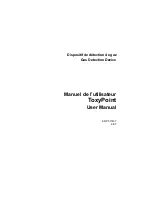
Page 1
INTRODUCTION
The CO
2
sensor series uses a highly accurate and reliable
non-dispersive infrared (NDIR) sensor in an attractive, duct
mount enclosure to monitor return air CO
2
levels for indoor
applications. The compact dual channel CO
2
sensor achieves
excellent performance characteristics, including high
accuracy and low power consumption to ensure stable long
term operation. The device is also available with an optional
resistive temperature sensor.
BEFORE INSTALLATION
Read these instructions carefully before installing and commissioning the device. Failure to follow these
instructions may result in product damage. Do not use in an explosive or hazardous environment, with
combustible or flammable gases, as a safety or emergency stop device or in any other application where
failure of the product could result in personal injury.
Take electrostatic discharge precautions during
installation and do not exceed the device ratings.
NOTE:
This CO
2
sensor incorporates a Self Calibration feature to correct CO
2
sensor drift. This CO
2
sensor
is recommended for applications where the CO
2
level will be close to normal (400 ppm) at least one hour
per day. If the monitored space is occupied 24 hours or consistently maintains higher levels of CO
2
level,
the CD Series is recommended.
MOUNTING
The CO
2
duct type sensor installs on the outside of a return air duct with the sampling tube inserted into
the duct. Mount the sensor in an easily accessible location in a straight section of duct at least five feet
from corners and other items that may cause disturbances in the air flow. Avoid areas where the detector
is exposed to vibrations or rapid temperature changes. See Figure 1.
The duct CO
2
detector principal of operation is based on the Venturi effect of the probe that extends into
the HVAC duct. Air flowing through the duct is forced into the vent holes on one side of the probe, into the
enclosure, over the CO
2
sensor and then is drawn back out of the enclosure via the probe vent holes on the
opposite side.
NOTE
to ensure proper humidity and temperature readings, the RH/T inlet on the probe must be installed
directly into the airflow. See Figure 1.
Drill or punch a 7/8” or 1” hole in the duct at the preferred location and insert the probe into the hole to mark
the enclosure mounting holes. Remove the unit and drill the two mounting holes. Clean all drilled holes
of debris before mounting the device. Mount the enclosure to the duct with two sheet metal screws such
that the duct air flow is parallel with the vent holes in the probe (i.e.: air flows directly into the probe holes).
To prevent air leaks, ensure the gasket is compressed around the probe between the device enclosure and
the air duct.
The enclosure has a hinged cover with a latch. Open the cover by pulling slightly on the latch on the
bottom side of the enclosure and at the same time pulling on the cover, as illustrated in Figure 2.
A 1/2" NPT threaded connection hole is provided in the left side of the enclosure. Screw the EMT connector
or cable gland connector in until tight. See Figure 3. It is recommended that weatherproof conduit or
cable gland fittings be used. The F style enclosure includes a 1/2" NPT to M16 thread adapter and cable
gland fitting.
Two security screws are provided which can be installed to help secure the cover once settings and wiring
connections are complete. See Figure 4.
Figure 1
Figure 3
Figure 2
Thread adapter and cable
gland fitting
EMT Connector
IN-GE-CEDTXXX-03
Copyright © Greystone Energy Systems, Inc. All Rights Reserved Phone: +1 506 853 3057 Web: www.greystoneenergy.com
Duct Carbon Dioxide Sensor
CEDT Series - Installation Instructions






















